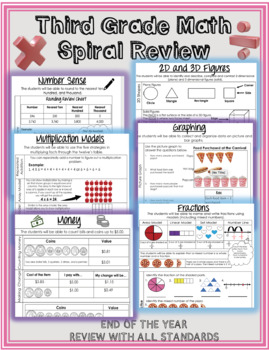Third Grade Math Spiral Review END OF THE YEAR REVIEW!
Crissy's Classroom Creations
11 Followers
Grade Levels
2nd - 4th
Subjects
Resource Type
Standards
CCSS3.MD.A.1
CCSS3.MD.A.2
CCSS3.MD.B.3
CCSS3.MD.B.4
CCSS3.MD.C.5
Formats Included
- PDF
Pages
27 pages
Crissy's Classroom Creations
11 Followers
Description
In this third grade math review packet you will find all of the standards aligned with the third grade SOLs. This can be used as a spiral review to refresh your kiddos on their skills learned throughout the year. This packet includes 27 pages:
- Fact Families
- Number Sense-Rounding
- Number Sense-Place Value
- Number Sense-Comparing Numbers
- Multiplication
- Division
- Computation (larger number addition and subtraction with regrouping)
- Estimation
- Money (counting and making change up to $5.00)
- Identifying Fractions
- Comparing Fractions
- Adding and Subtracting fractions with like denominators
- Probability and Combinations
- Graphing (picture and bar graph)
- Linear Measurement
- Weight and Mass
- Capacity
- Time and Elapsed Time
- Period of Time
- Temperature
- Area and Perimeter
- Geometry (lines, angles, congruency)
- Geometry Plane and Solid shapes (2D/3D)
- Patterns
Thank you so much purchasing! I hope you enjoy!
Total Pages
27 pages
Answer Key
N/A
Teaching Duration
N/A
Report this resource to TPT
Reported resources will be reviewed by our team. Report this resource to let us know if this resource violates TPT’s content guidelines.
Standards
to see state-specific standards (only available in the US).
CCSS3.MD.A.1
Tell and write time to the nearest minute and measure time intervals in minutes. Solve word problems involving addition and subtraction of time intervals in minutes, e.g., by representing the problem on a number line diagram.
CCSS3.MD.A.2
Measure and estimate liquid volumes and masses of objects using standard units of grams (g), kilograms (kg), and liters (l). Add, subtract, multiply, or divide to solve one-step word problems involving masses or volumes that are given in the same units, e.g., by using drawings (such as a beaker with a measurement scale) to represent the problem.
CCSS3.MD.B.3
Draw a scaled picture graph and a scaled bar graph to represent a data set with several categories. Solve one- and two-step “how many more” and “how many less” problems using information presented in scaled bar graphs. For example, draw a bar graph in which each square in the bar graph might represent 5 pets.
CCSS3.MD.B.4
Generate measurement data by measuring lengths using rulers marked with halves and fourths of an inch. Show the data by making a line plot, where the horizontal scale is marked off in appropriate units-whole numbers, halves, or quarters.
CCSS3.MD.C.5
Recognize area as an attribute of plane figures and understand concepts of area measurement.





